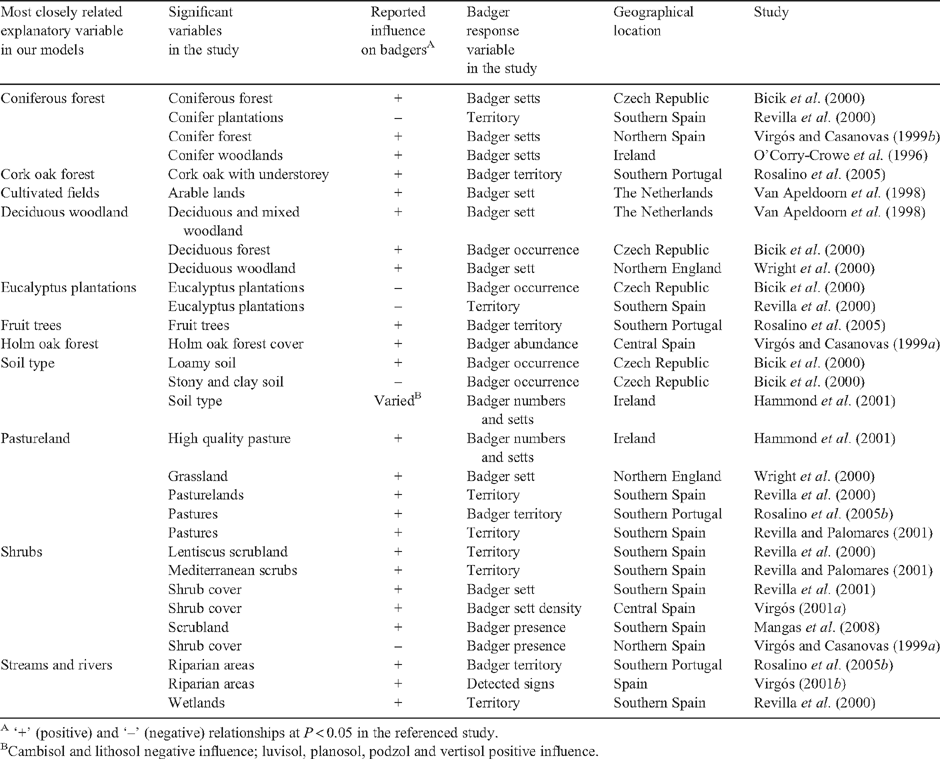Habitat selection by European badgers at multiple spatial scales in Portuguese Mediterranean ecosystems
Maria J. Santos A B D and Paul Beier CA Center for Environmental Sciences and Education, Northern Arizona University, Flagstaff, PO Box 5694, AZ 86001-5694, USA.
B Current address: Department of Land, Air and Water Resources, One Shields Avenue, Davis, CA 95616-8585, USA.
C School of Forestry and Merriam-Powell Center for Environmental Research, Northern Arizona University, Flagstaff, PO Box 5018, AZ 86011-5018, USA.
D Corresponding author. Email: mjsantos@ucdavis.edu
Wildlife Research 35(8) 835-843 https://doi.org/10.1071/WR08009
Submitted: 22 January 2008 Accepted: 4 August 2008 Published: 16 December 2008
Abstract
Different habitat features can limit animal populations at different spatial scales. We examined habitat selection by Eurasian badger in a montado landscape in southern Portugal at four scales: core area (1 km2), home range (4 km2), social group territory (25 km2), and local population (100 km2). Our goals were to identify important habitats for conservation at each spatial scale (cell size) using candidate variables shown to be important by previous research. As expected, across all scales, badger occurrence was consistently and strongly correlated with dominance of cork oak and deciduous woodlands, and badgers seemed to avoid cultivated fields. Contrary to expectation, monocultures of conifers contributed positively to badger detection. The predictive ability of the models was poor at all scales, probably owing to our inability to include factors such as food, competitors, predators, undercover vegetation, and roads. Nonetheless, the models illustrate the importance to badgers of the montado, an ancient human-modified ecosystem that is threatened by current European Union agricultural conversion policies.
Acknowledgements
We thank the Luso-American Foundation for Development (FLAD) for funding, and the following institutions and people for providing data: CBA, CNIG, ICN, Évora University, and CEAI, Dr Margarida Santos-Reis, Dr António Mira, Dr Luís Miguel Rosalino, Filipa Loureiro, Hugo Matos, Nuno Pedroso, Teresa Sales-Luís, Iris Pereira, Joaquim Pedro Ferreira, Bruno Pinto, Silvia Carvalho, Sónia Domingos, João Tiago Marques, Rita Alcazar, Margarida Lopes Fernandes and Fernando Ascensão for additional data. John Prather, J. Judson Wynne and James Battin provided statistical advice. We also thank two anonymous reviewers for their comments that improved an earlier version of this manuscript.
Barea-Azcón, J. M. , Virgós, E. , Ballesteros-Duperon, E. , Moleon, M. , and Chirosa, M. (2007). Surveying carnivores at large spatial scales: a comparison of four broad-applied methods. Biodiversity and Conservation 16, 1213–1230.
| Crossref | GoogleScholarGoogle Scholar |
Carroll, S. S. , and Pearson, D. L. (2000). Detecting and modeling spatial and temporal dependence in conservation biology. Conservation Biology 14, 1893–1897.
| Crossref | GoogleScholarGoogle Scholar |
Joffre, R. , Rambal, S. , and Ratte, J. P. (1999). The dehesa system of southern Spain and Portugal as a natural ecosystem mimic. Agroforestry Systems 45, 57–79.
| Crossref | GoogleScholarGoogle Scholar |
Newton-Cross, G. , White, P. C. L. , and Harris, S. (2007). Modelling the distribution of badgers Meles meles: comparing predictions from field-based and remotely derived habitat data. Mammal Review 37, 54–70.
| Crossref | GoogleScholarGoogle Scholar |
Sadlier, L. M. J. , Webbon, C. C. , Baker, P. J. , and Harris, S. (2004). Methods of monitoring red foxes Vulpes vulpes and badgers Meles meles: are field signs the answer? Mammal Review 34, 75–98.
| Crossref | GoogleScholarGoogle Scholar |
Seiler, A. , Lindström, E. R. , and Stenström, D. (1995). Badger activity and abundance in relation to fragmentation of foraging biotopes. Annales Zoologici Fennici 32, 37–45.
Wright, A. , Fielding, A. H. , and Wheater, C. P. (2000). Predicting the distribution of Eurasian Badger (Meles meles) setts over an urbanized landscape: a GIS approach. Photogrammetric Engineering and Remote Sensing 66, 423–428.

|


